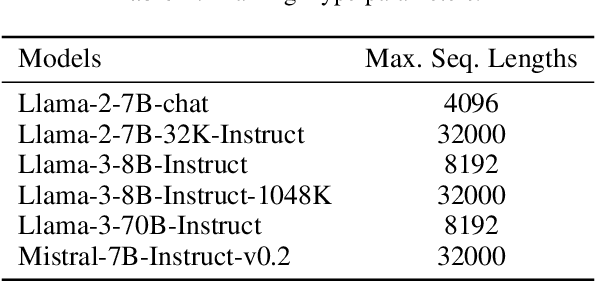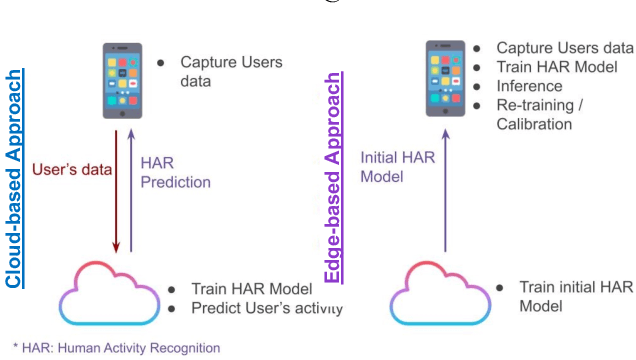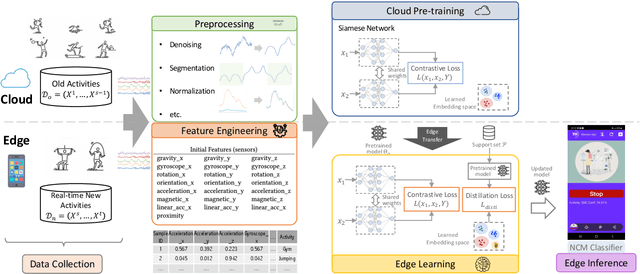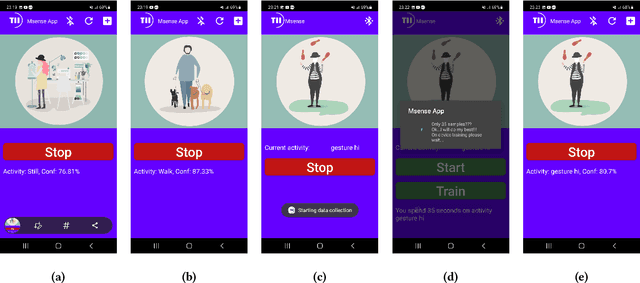Jingwei Zuo
Falcon-H1: A Family of Hybrid-Head Language Models Redefining Efficiency and Performance
Jul 30, 2025Abstract:In this report, we introduce Falcon-H1, a new series of large language models (LLMs) featuring hybrid architecture designs optimized for both high performance and efficiency across diverse use cases. Unlike earlier Falcon models built solely on Transformer or Mamba architectures, Falcon-H1 adopts a parallel hybrid approach that combines Transformer-based attention with State Space Models (SSMs), known for superior long-context memory and computational efficiency. We systematically revisited model design, data strategy, and training dynamics, challenging conventional practices in the field. Falcon-H1 is released in multiple configurations, including base and instruction-tuned variants at 0.5B, 1.5B, 1.5B-deep, 3B, 7B, and 34B parameters. Quantized instruction-tuned models are also available, totaling over 30 checkpoints on Hugging Face Hub. Falcon-H1 models demonstrate state-of-the-art performance and exceptional parameter and training efficiency. The flagship Falcon-H1-34B matches or outperforms models up to 70B scale, such as Qwen3-32B, Qwen2.5-72B, and Llama3.3-70B, while using fewer parameters and less data. Smaller models show similar trends: the Falcon-H1-1.5B-Deep rivals current leading 7B-10B models, and Falcon-H1-0.5B performs comparably to typical 7B models from 2024. These models excel across reasoning, mathematics, multilingual tasks, instruction following, and scientific knowledge. With support for up to 256K context tokens and 18 languages, Falcon-H1 is suitable for a wide range of applications. All models are released under a permissive open-source license, underscoring our commitment to accessible and impactful AI research.
NeurIPS 2025 E2LM Competition : Early Training Evaluation of Language Models
Jun 09, 2025Abstract:Existing benchmarks have proven effective for assessing the performance of fully trained large language models. However, we find striking differences in the early training stages of small models, where benchmarks often fail to provide meaningful or discriminative signals. To explore how these differences arise, this competition tackles the challenge of designing scientific knowledge evaluation tasks specifically tailored for measuring early training progress of language models. Participants are invited to develop novel evaluation methodologies or adapt existing benchmarks to better capture performance differences among language models. To support this effort, we provide three pre-trained small models (0.5B, 1B, and 3B parameters), along with intermediate checkpoints sampled during training up to 200B tokens. All experiments and development work can be run on widely available free cloud-based GPU platforms, making participation accessible to researchers with limited computational resources. Submissions will be evaluated based on three criteria: the quality of the performance signal they produce, the consistency of model rankings at 1 trillion tokens of training, and their relevance to the scientific knowledge domain. By promoting the design of tailored evaluation strategies for early training, this competition aims to attract a broad range of participants from various disciplines, including those who may not be machine learning experts or have access to dedicated GPU resources. Ultimately, this initiative seeks to make foundational LLM research more systematic and benchmark-informed from the earliest phases of model development.
DuoAttention: Efficient Long-Context LLM Inference with Retrieval and Streaming Heads
Oct 14, 2024



Abstract:Deploying long-context large language models (LLMs) is essential but poses significant computational and memory challenges. Caching all Key and Value (KV) states across all attention heads consumes substantial memory. Existing KV cache pruning methods either damage the long-context capabilities of LLMs or offer only limited efficiency improvements. In this paper, we identify that only a fraction of attention heads, a.k.a, Retrieval Heads, are critical for processing long contexts and require full attention across all tokens. In contrast, all other heads, which primarily focus on recent tokens and attention sinks--referred to as Streaming Heads--do not require full attention. Based on this insight, we introduce DuoAttention, a framework that only applies a full KV cache to retrieval heads while using a light-weight, constant-length KV cache for streaming heads, which reduces both LLM's decoding and pre-filling memory and latency without compromising its long-context abilities. DuoAttention uses a lightweight, optimization-based algorithm with synthetic data to identify retrieval heads accurately. Our method significantly reduces long-context inference memory by up to 2.55x for MHA and 1.67x for GQA models while speeding up decoding by up to 2.18x and 1.50x and accelerating pre-filling by up to 1.73x and 1.63x for MHA and GQA models, respectively, with minimal accuracy loss compared to full attention. Notably, combined with quantization, DuoAttention enables Llama-3-8B decoding with 3.3 million context length on a single A100 GPU. Code is provided in https://github.com/mit-han-lab/duo-attention.
Falcon Mamba: The First Competitive Attention-free 7B Language Model
Oct 07, 2024



Abstract:In this technical report, we present Falcon Mamba 7B, a new base large language model based on the novel Mamba architecture. Falcon Mamba 7B is trained on 5.8 trillion tokens with carefully selected data mixtures. As a pure Mamba-based model, Falcon Mamba 7B surpasses leading open-weight models based on Transformers, such as Mistral 7B, Llama3.1 8B, and Falcon2 11B. It is on par with Gemma 7B and outperforms models with different architecture designs, such as RecurrentGemma 9B and RWKV-v6 Finch 7B/14B. Currently, Falcon Mamba 7B is the best-performing Mamba model in the literature at this scale, surpassing both existing Mamba and hybrid Mamba-Transformer models, according to the Open LLM Leaderboard. Due to its architecture, Falcon Mamba 7B is significantly faster at inference and requires substantially less memory for long sequence generation. Despite recent studies suggesting that hybrid Mamba-Transformer models outperform pure architecture designs, we demonstrate that even the pure Mamba design can achieve similar, or even superior results compared to the Transformer and hybrid designs. We make the weights of our implementation of Falcon Mamba 7B publicly available on https://huggingface.co/tiiuae/falcon-mamba-7b, under a permissive license.
MAGNETO: Edge AI for Human Activity Recognition -- Privacy and Personalization
Feb 14, 2024


Abstract:Human activity recognition (HAR) is a well-established field, significantly advanced by modern machine learning (ML) techniques. While companies have successfully integrated HAR into consumer products, they typically rely on a predefined activity set, which limits personalizations at the user level (edge devices). Despite advancements in Incremental Learning for updating models with new data, this often occurs on the Cloud, necessitating regular data transfers between cloud and edge devices, thus leading to data privacy issues. In this paper, we propose MAGNETO, an Edge AI platform that pushes HAR tasks from the Cloud to the Edge. MAGNETO allows incremental human activity learning directly on the Edge devices, without any data exchange with the Cloud. This enables strong privacy guarantees, low processing latency, and a high degree of personalization for users. In particular, we demonstrate MAGNETO in an Android device, validating the whole pipeline from data collection to result visualization.
Practical Insights on Incremental Learning of New Human Physical Activity on the Edge
Aug 22, 2023Abstract:Edge Machine Learning (Edge ML), which shifts computational intelligence from cloud-based systems to edge devices, is attracting significant interest due to its evident benefits including reduced latency, enhanced data privacy, and decreased connectivity reliance. While these advantages are compelling, they introduce unique challenges absent in traditional cloud-based approaches. In this paper, we delve into the intricacies of Edge-based learning, examining the interdependencies among: (i) constrained data storage on Edge devices, (ii) limited computational power for training, and (iii) the number of learning classes. Through experiments conducted using our MAGNETO system, that focused on learning human activities via data collected from mobile sensors, we highlight these challenges and offer valuable perspectives on Edge ML.
AgentVerse: Facilitating Multi-Agent Collaboration and Exploring Emergent Behaviors in Agents
Aug 21, 2023



Abstract:Autonomous agents empowered by Large Language Models (LLMs) have undergone significant improvements, enabling them to generalize across a broad spectrum of tasks. However, in real-world scenarios, cooperation among individuals is often required to enhance the efficiency and effectiveness of task accomplishment. Hence, inspired by human group dynamics, we propose a multi-agent framework \framework that can collaboratively and dynamically adjust its composition as a greater-than-the-sum-of-its-parts system. Our experiments demonstrate that \framework framework can effectively deploy multi-agent groups that outperform a single agent. Furthermore, we delve into the emergence of social behaviors among individual agents within a group during collaborative task accomplishment. In view of these behaviors, we discuss some possible strategies to leverage positive ones and mitigate negative ones for improving the collaborative potential of multi-agent groups. Our codes for \framework will soon be released at \url{https://github.com/OpenBMB/AgentVerse}.
Opportunistic Air Quality Monitoring and Forecasting with Expandable Graph Neural Networks
Jul 29, 2023Abstract:Air Quality Monitoring and Forecasting has been a popular research topic in recent years. Recently, data-driven approaches for air quality forecasting have garnered significant attention, owing to the availability of well-established data collection facilities in urban areas. Fixed infrastructures, typically deployed by national institutes or tech giants, often fall short in meeting the requirements of diverse personalized scenarios, e.g., forecasting in areas without any existing infrastructure. Consequently, smaller institutes or companies with limited budgets are compelled to seek tailored solutions by introducing more flexible infrastructures for data collection. In this paper, we propose an expandable graph attention network (EGAT) model, which digests data collected from existing and newly-added infrastructures, with different spatial structures. Additionally, our proposal can be embedded into any air quality forecasting models, to apply to the scenarios with evolving spatial structures. The proposal is validated over real air quality data from PurpleAir.
Unleashing Realistic Air Quality Forecasting: Introducing the Ready-to-Use PurpleAirSF Dataset
Jun 24, 2023Abstract:Air quality forecasting has garnered significant attention recently, with data-driven models taking center stage due to advancements in machine learning and deep learning models. However, researchers face challenges with complex data acquisition and the lack of open-sourced datasets, hindering efficient model validation. This paper introduces PurpleAirSF, a comprehensive and easily accessible dataset collected from the PurpleAir network. With its high temporal resolution, various air quality measures, and diverse geographical coverage, this dataset serves as a useful tool for researchers aiming to develop novel forecasting models, study air pollution patterns, and investigate their impacts on health and the environment. We present a detailed account of the data collection and processing methods employed to build PurpleAirSF. Furthermore, we conduct preliminary experiments using both classic and modern spatio-temporal forecasting models, thereby establishing a benchmark for future air quality forecasting tasks.
On Handling Catastrophic Forgetting for Incremental Learning of Human Physical Activity on the Edge
Feb 18, 2023



Abstract:Human activity recognition (HAR) has been a classic research problem. In particular, with recent machine learning (ML) techniques, the recognition task has been largely investigated by companies and integrated into their products for customers. However, most of them apply a predefined activity set and conduct the learning process on the cloud, hindering specific personalizations from end users (i.e., edge devices). Even though recent progress in Incremental Learning allows learning new-class data on the fly, the learning process is generally conducted on the cloud, requiring constant data exchange between cloud and edge devices, thus leading to data privacy issues. In this paper, we propose PILOTE, which pushes the incremental learning process to the extreme edge, while providing reliable data privacy and practical utility, e.g., low processing latency, personalization, etc. In particular, we consider the practical challenge of extremely limited data during the incremental learning process on edge, where catastrophic forgetting is required to be handled in a practical way. We validate PILOTE with extensive experiments on human activity data collected from mobile sensors. The results show PILOTE can work on edge devices with extremely limited resources while providing reliable performance.
 Add to Chrome
Add to Chrome Add to Firefox
Add to Firefox Add to Edge
Add to Edge